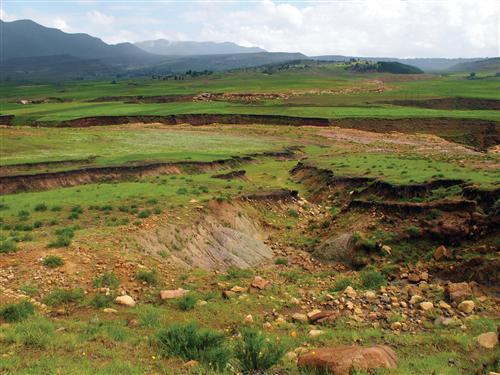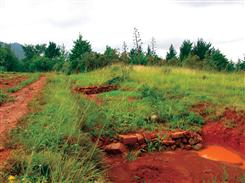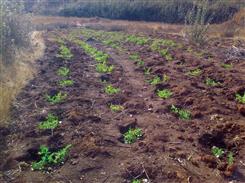In Lesotho, 80% of the population live in rural areas, with more than half of the population reliant on agricultural crops and livestock for their livelihood. In 2003 38% of Lesotho’s population worked as small-hold farmers on farms generally less than 1 ha. Maize is the most popular crop, accounting for 60 % of the cropped area with sorghum contributing between 10 % and 20 %, wheat 10 % and beans about 6 %. Virtually all agriculture is rainfed and doesn’t depend on artificial irrigation. Lesotho, because of the extremely low productivity of its agricultural sector, is reliant on food imports and annually imports about 60% of its maize requirements and 80% of its wheat requirements.

Dongas in Lesotho - soil erosion causes serious damage to agricultural land across the country due to poor land use management practices.
Source:Kruchem 2011
( click to enlarge )
Lesotho’s fight against soil erosion
86% of Lesotho’s working-age population resort to subsistence farming, which however contributes a mere 8.4% of the gross domestic product. This is mainly, because Lesotho’s steep slopes and poor soils do not lend themselves to productive farming. The only viable areas are in the western lowlands around the capital Maseru, which are already fully utilised. Young families and returning workers from South Africa who want space to plant crops and graze livestock have to move ever higher into the mountains.
The mountain farmers establish fields on highly erodible soils of volcanic origin. These are not improved by ploughing, in some cases with furrows running downhill that make the situation even worse. Only about 3% of farmers have access to electricity, so there is widespread felling of highlands shrubs for firewood. This too affects soil stability. Worst of all, Lesotho’s farmers own a combined herd of hundreds of thousands of cattle which are regarded as status symbols and permitted to graze wherever they please.
This has catastrophic results for any topsoil that remains. When a thunderstorm triggers a cloudburst, exposed topsoil is quickly eroded and washed into valleys, streams and rivers. Fields and pastures melt away as red-brown rivulets. The result is a barren network of “dongas”, erosion gullies, sometimes 20 metres wide and 10 metres deep: As a result of this rapid erosion Lesotho loses up to 2% of its vital topsoil every year.
This problem has loomed for a considerable time and is a chronic, progressively worsening calamity that the BaSotho and international development agencies seem helpless to stem. Government and international partners have initiated a number of campaigns aimed at promoting the use of sustainable farming methods, but so far to little avail.
What can Lesotho do about these destructive practices? – Khomoatsana Tau, deputy permanent secretary of the Ministry of Natural Resources and an ORASECOM commissioner, approaches the problem practically: “We need to reduce the number of cattle in the mountains of Lesotho and use pastures on a rotating basis. Only then can we reduce erosion and give the soils enough time to recover.” Tau suggests that there’s a need for fenced pastures and farming co-operatives, but admits that in Lesotho this would be difficult to implement. “Over and over again we explain to farmers why they need to adopt different practices. On top of that there’s a need for new laws and incentives to make sure people keep fewer animals.”
There is another issue: If farmers owned the land they are working, they would have an incentive to manage their soils better, quite a few people assume. They would, for example, build more terraces on the slopes to prevent erosion. But land ownership is controversial in Lesotho and politicians are worried about burning their fingers.
In spite of all the difficulties there are successful efforts to conserve Lesotho’s precious soil. Two examples:
Stopping Erosion with "Potholes" and "Keyholes"
Sello Thulo, until shortly programme director with the aid organisation CARE in Maseru, has helped farmers to adapt their practices to local circumstances. One initiative is known as “potholing”. This requires a farmer to dig a series of holes, each 30 by 30 by 30 centimetres. The holes are one metre apart and run in rows parallel to the slope, but offset from their neighbours. Fertilised with ash and dung, they are planted with maize, beans or sorghum while surrounding weeds are kept in check. In the first year this is strenuous work; but after CARE offered support in the form of seeds and spades, from the second year the fields of potholes had a dramatic effect: The hollows caught eroded soil and water coming down the slope. As a result the ground started to stabilise and crops thrived.” To date some 3 000 families have dug between 700 and 1 200 potholes each, and their successes are encouraging others.
In tandem with the pothole scheme, Thulo encouraged “keyhole gardens” for vegetables. These consist of beds measuring two to four square metres. They are raised hip-high and fringed by stones, which protect them from livestock, wind and flooding. Farmers’ wives mix ash, dung and earth to create fertile soil for cabbages, tomatoes or onions. On one side the bed has a narrow entrance – the keyhole – to allow watering, harvesting and tending of vegetables.
Harvesting the Neighbours' Soil
Maseredse Musi, now 84, grew up in the town of Morija near Maseru and became a teacher. When she married Molikeng Fanuel Musi, a motor vehicle mechanic, they moved to his place of birth, the remote Malealea valley in West Lesotho. Here the couple created something exceptional.
The chief of Molikeng’s hamlet had granted him three fields, the largest of them two hectares in size. One night in January 1986 this field was devastated by a storm. “On the following morning, my husband could not even walk on his land,” the old woman reminisces in her comfortable kitchen-living room. Torrential downpours had ripped the field to pieces and it was riddled with dongas each several metres deep. Making matters still worse, water was still running in the dongas and carrying away yet more soil. “My husband got angry,” Maseredse relates solemnly, but with a wink. “He did not want strangers further down the Senqu to benefit from his topsoil.” At a village assembly Musi tried to persuade other farmers to unite in fighting the erosion and loss of land, and to rebuild the fields. “But they just laughed. ‘Musi,’ they said. ‘You will be wasting your time’.”
Intent on making a difference, Molikeng Musi received the chief’s permission to give nature a helping hand. He hauled in rocks, initially on his back, then by wheelbarrow, and ultimately by tractor and trailer. With his neighbours watching, he built stone barriers in the dongas so as to stop erosion. Within a short period fertile topsoil began collecting. “Our neighbours up the hill didn’t realise they were giving us their soil. Before long we were able to plant table grapes, apple trees, peach trees; maize, wheat, beans and tomatoes.”
Molikeng Musi toiled for eleven years, with his wife and growing children doing what they could to help. Their neighbours envied the project’s success but still refused to follow suit. When Musi died in 1997, his legacy was a green paradise of fruit trees and vegetable patches which are now the responsibility of his son Albert.
 Stone dams placed in erosion dongas reduces the impacts of soil erosion. Source:Kruchem 2011 ( click to enlarge ) |
 A pothole field in Lesotho. Source:Kruchem 2011 ( click to enlarge ) |
